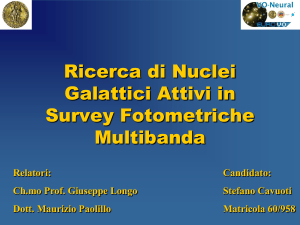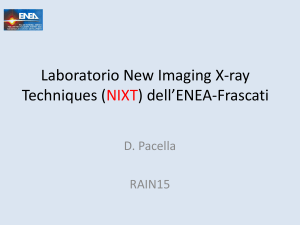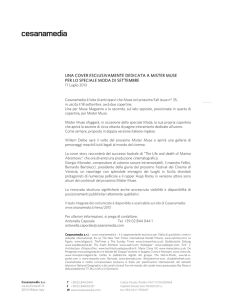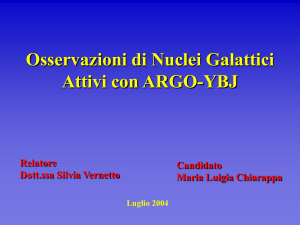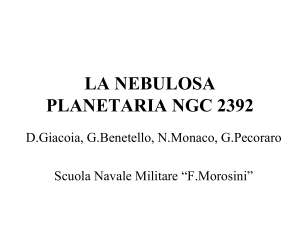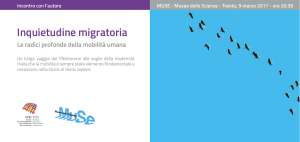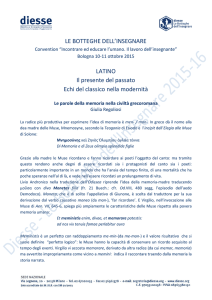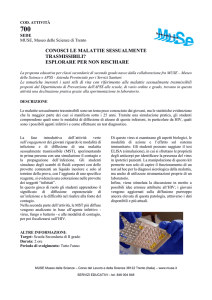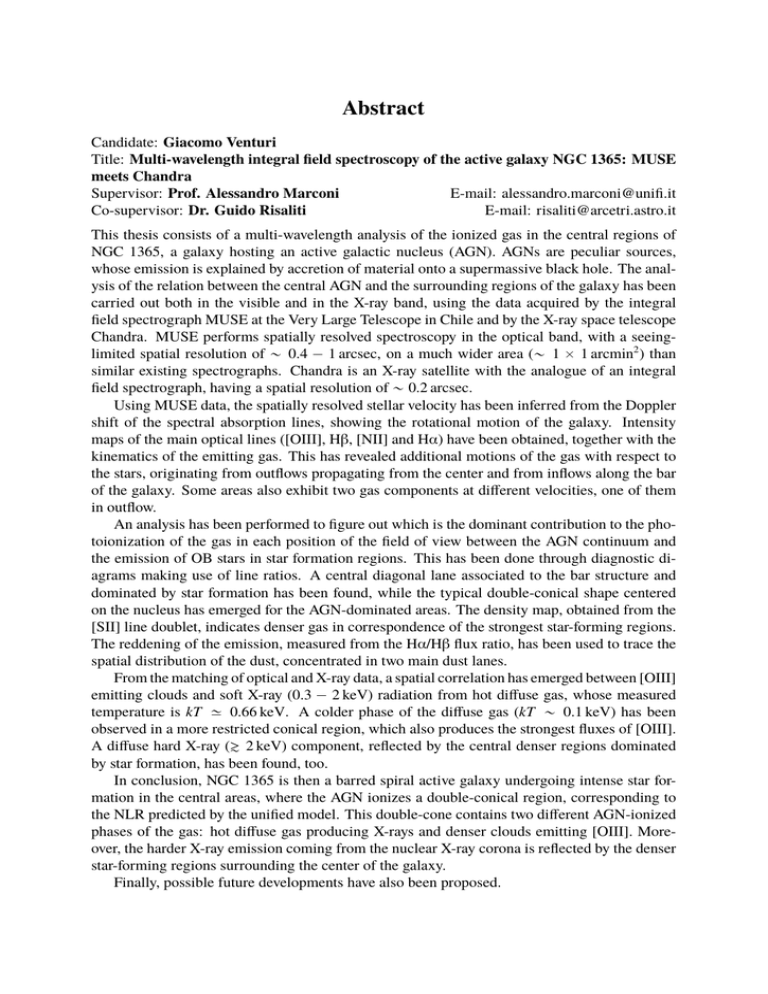
Abstract
Candidate: Giacomo Venturi
Title: Multi-wavelength integral field spectroscopy of the active galaxy NGC 1365: MUSE
meets Chandra
Supervisor: Prof. Alessandro Marconi
E-mail: [email protected]
Co-supervisor: Dr. Guido Risaliti
E-mail: [email protected]
This thesis consists of a multi-wavelength analysis of the ionized gas in the central regions of
NGC 1365, a galaxy hosting an active galactic nucleus (AGN). AGNs are peculiar sources,
whose emission is explained by accretion of material onto a supermassive black hole. The analysis of the relation between the central AGN and the surrounding regions of the galaxy has been
carried out both in the visible and in the X-ray band, using the data acquired by the integral
field spectrograph MUSE at the Very Large Telescope in Chile and by the X-ray space telescope
Chandra. MUSE performs spatially resolved spectroscopy in the optical band, with a seeinglimited spatial resolution of 0.4 1 arcsec, on a much wider area ( 1 1 arcmin2 ) than
similar existing spectrographs. Chandra is an X-ray satellite with the analogue of an integral
field spectrograph, having a spatial resolution of 0.2 arcsec.
Using MUSE data, the spatially resolved stellar velocity has been inferred from the Doppler
shift of the spectral absorption lines, showing the rotational motion of the galaxy. Intensity
maps of the main optical lines ([OIII], Hβ, [NII] and Hα) have been obtained, together with the
kinematics of the emitting gas. This has revealed additional motions of the gas with respect to
the stars, originating from outflows propagating from the center and from inflows along the bar
of the galaxy. Some areas also exhibit two gas components at different velocities, one of them
in outflow.
An analysis has been performed to figure out which is the dominant contribution to the photoionization of the gas in each position of the field of view between the AGN continuum and
the emission of OB stars in star formation regions. This has been done through diagnostic diagrams making use of line ratios. A central diagonal lane associated to the bar structure and
dominated by star formation has been found, while the typical double-conical shape centered
on the nucleus has emerged for the AGN-dominated areas. The density map, obtained from the
[SII] line doublet, indicates denser gas in correspondence of the strongest star-forming regions.
The reddening of the emission, measured from the Hα/Hβ flux ratio, has been used to trace the
spatial distribution of the dust, concentrated in two main dust lanes.
From the matching of optical and X-ray data, a spatial correlation has emerged between [OIII]
emitting clouds and soft X-ray (0.3 2 keV) radiation from hot diffuse gas, whose measured
temperature is kT 0.66 keV. A colder phase of the diffuse gas (kT 0.1 keV) has been
observed in a more restricted conical region, which also produces the strongest fluxes of [OIII].
A diffuse hard X-ray (& 2 keV) component, reflected by the central denser regions dominated
by star formation, has been found, too.
In conclusion, NGC 1365 is then a barred spiral active galaxy undergoing intense star formation in the central areas, where the AGN ionizes a double-conical region, corresponding to
the NLR predicted by the unified model. This double-cone contains two different AGN-ionized
phases of the gas: hot diffuse gas producing X-rays and denser clouds emitting [OIII]. Moreover, the harder X-ray emission coming from the nuclear X-ray corona is reflected by the denser
star-forming regions surrounding the center of the galaxy.
Finally, possible future developments have also been proposed.
Abstract
Candidato: Giacomo Venturi
Titolo: Spettroscopia 3D multibanda della galassia attiva NGC 1365: confronto tra dati
MUSE e Chandra
Relatore: Prof. Alessandro Marconi
E-mail: [email protected]
Correlatore: Dr. Guido Risaliti
E-mail: [email protected]
In questa tesi è stata eseguita un’analisi multibanda del gas ionizzato nelle regioni centrali
della galassia NGC 1365, al cui interno si trova un nucleo galattico attivo (AGN). Gli AGN
sono oggetti peculiari, la cui emissione può essere spiegata facendo ricorso al processo di accrescimento di materia su un buco nero supermassivo. Al fine di analizzare l’interazione fra
l’AGN centrale e le regioni circostanti della galassia, sono stati utilizzati sia dati nella banda
visibile forniti dallo spettrografo 3D MUSE, sia dati nella banda X ottenuti con il telescopio
spaziale Chandra. MUSE, situato al Very Large Telescope in Cile, permette di eseguire spettroscopia spazialmente risolta in banda ottica, con una risoluzione spaziale (limitata dal seeing)
di 0.4 1 arcsec, su campo di vista ben più ampio ( 1 1 arcmin2 ) di altri spettrografi 3D
esistenti. Chandra è un satellite avente l’analogo in banda X di uno spettragrafo 3D, dotato di
una risoluzione spaziale di 0.2 arcsec.
I dati di MUSE hanno permesso di tracciare la velocità delle stelle, da cui è emerso il profilo
di rotazione della galassia. Sono state quindi realizzate mappe d’intensità delle principali righe
in banda ottica ([OIII], Hβ, [NII] e Hα), oltre a mappe di velocità del gas che le produce. Ciò
ha rivelato moti aggiuntivi del gas rispetto alle stelle, dovuti a venti spinti dalle regioni centrali
e a flussi in direzione del nucleo all’interno della barra. Alcune zone mostrano due distinte
componenti di velocità del gas, una delle quali in outflow.
È stato poi discriminato, nelle varie parti della galassia, il contributo dominante alla fotoionizzazione del gas fra il continuo dell’AGN e l’emissione di stelle OB nelle regioni di formazione
stellare. Per far ciò, sono stati utilizzati diagrammi diagnostici basati su rapporti di righe di
emissione. È stata in questo modo identificata una fascia diagonale attorno al centro dominata
dalla formazione stellare, mentre la tipica forma a doppio cono è emersa per quanto riguarda
le regioni fortemente ionizzate dall’AGN. La mappa di densità, ottenuta tramite il rapporto del
doppietto [SII], ha rivelato un massimo della densità del gas in corrispondenza delle regioni di
forte formazione stellare di cui sopra. Il rapporto Hα/Hβ ha permesso di tracciare l’arrossamento
della radiazione causato dalla polvere.
Il confronto fra dati ottici e X ha mostrato una correlazione spaziale fra l’emissione di [OIII]
e quella X meno enegetica (0.3 2 keV), dovuta a gas caldo diffuso, la cui temperatura misurata
è kT 0.66 keV. All’interno di una zona di forma conica in cui si osserva l’emissione più
intensa di [OIII], è stata anche trovata una fase più fredda del suddetto gas diffuso, avente una
temperatura kT 0.1 keV. Raggi X energetici (& 2 keV) sono invece stati individuati in un’area
diffusa circostante il centro, riflessi dalle regioni più dense dominate dalla formazione stellare.
Lo scenario emerso per NGC 1365 mostra quindi una galassia a spirale barrata avente un nucleo
attivo, nelle cui regioni centrali vi è forte formazione stellare; l’AGN ionizza il gas in un doppio
cono, come previsto dal modello unificato. In questo doppio cono vi sono due diverse fasi del gas
ionizzato dall’AGN: una più diffusa e calda che irradia in banda X, un’altra costituita da nubi più
dense che emettono [OIII]. Inoltre, i raggi X più energetici, provenienti dal nucleo, sono riflessi
dal gas denso circostante, in cui un’intensa formazione stellare è in atto.
Infine, sono stati anche discussi i possibili sviluppi futuri di questo lavoro.


